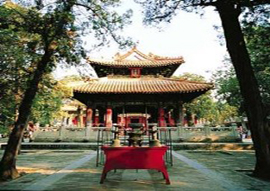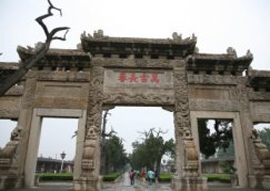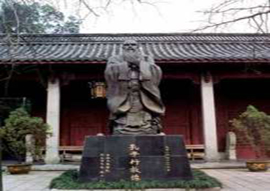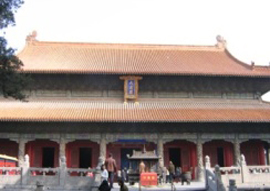The Temple and Cemetery of Confucius and the Kong Family Mansion were included in the world  cultural heritage list in 1994. They occupy special positions in China's ancient temple, mausoleums and official residences with their complete systems, well-knit layouts, and unusual commemorative significance, and exert great influence in the memorial structures, gardens and human residences in the Chinese and Eastern cultural circles. The three existing historical sites were constructed in the Ming and Qing dynasties, representing China's highest architectural level at that time. cultural heritage list in 1994. They occupy special positions in China's ancient temple, mausoleums and official residences with their complete systems, well-knit layouts, and unusual commemorative significance, and exert great influence in the memorial structures, gardens and human residences in the Chinese and Eastern cultural circles. The three existing historical sites were constructed in the Ming and Qing dynasties, representing China's highest architectural level at that time.
The Temple of Confucius, also known as the sacred temple, in located in the city proper of Qufu. As a place for people to worship Confucius, the temple was a materialized symbol of the status of Confucianism in the whole feudal society. The inscriptions on the gate, memorial archways, halls and horizontal scribed boards are all from the ancient books and records of Confucianism, speaking highly of Confucius and Confucian ideological doctrines. The temple, which fully showcases the characteristics of the traditional Chinese wooden architecture, is a lofty cultural and artistic hall standing in the East. The temple was first constructed in 478 B.C., or the second year after Confucius passed away. At the beginning, the temple has only three halls built in front of the old residence of Confucius, where Confucius'clothes, chariots and books were on display, and the sacrificial ceremony was held every year. Later, the emperors showed great respect for Confucius and Confucianism, and Confucius was bestowed with numerous honorary titles by the feudal rules. As a result, the temple was continuously renovated and expanded until it became a magnificent architectural complex. Now the temple is about one kilometer long from south to north,  with three gates and nine courtyards along a south-north central axis. Symmetrical in its layout, the temple is well designed, and looks splendid in green and gold. The main buildings in the Temple of Confucius are three halls, one pavilion and one altar, i.e Dacheng Hall, Qin Hall, Shengji Hall, Kuiwen Pavilion and Apricot Altar. Dacheng Hall has 10 huge stone pillars, which are entwined with dragons amidst clouds, rockeries and waves carved in high bas-relief, displaying high craftsmanship. In front of Dacheng Hall sits Apricot Altar, where Confucius used to give lectures. It is the oldest forum in China. with three gates and nine courtyards along a south-north central axis. Symmetrical in its layout, the temple is well designed, and looks splendid in green and gold. The main buildings in the Temple of Confucius are three halls, one pavilion and one altar, i.e Dacheng Hall, Qin Hall, Shengji Hall, Kuiwen Pavilion and Apricot Altar. Dacheng Hall has 10 huge stone pillars, which are entwined with dragons amidst clouds, rockeries and waves carved in high bas-relief, displaying high craftsmanship. In front of Dacheng Hall sits Apricot Altar, where Confucius used to give lectures. It is the oldest forum in China.
The Temple of Confucius embraces over 1,000 steles, which are precious materials for the study of the politics, ideology and culture of the past ages and the evolution of the temple in the past ages, as well as the gems of the Chinese calligraphic arts. A large number of stone engraving works of art can be found in the temple, of which the stone frescoes of the Han Dynasty, The Trails of the Sage, and the stone pillars entwined with dragons in high bas relief of the Ming and Qing dynasties are the most famous. When entering the Temple of Confucius, tourist will widen their field of vision and their souls will receive the baptism.
The Kong Family Mansion, or the Residence of Duke Yansheng, borders the Temple of Confucius in the west. It is the place where the descendants of Confucius lived and handled affairs. As a feudal noble manor with the longest history, the mansion is a typical architectural structure of the feudal society integrating offices and residences. After the Han Dynasty, all the emperors held the esteem of  Confucius, and his descendants received titles and honors time and again. In 1055 Emperor Renzong of the Song Dynasty bestowed Confucius male descendant of the 46th generation with the title of Duke Yansheng. The title was passed down for 32 generations until the Republic of China, extending 880 years. First constructed in 1377, the Kong Family Mansion has nine courtyards and three routes. The houses along the middle route are offices, with residences at the rear, which are linked with a garden. The mansion is a magnificent noble's residence, only next to the former Imperial Palace in Beijing, hence the name the No.1 residence on earth. The mansion holds of the Ming and Qing dynasties, which recorded various activities of the Kong Family Mansion in more than 400 years. As the oldest private archives with the large number of documents, the Kong Family Mansion is of great importance for the study of the economy and culture of the Ming and Qing dynasties. Confucius, and his descendants received titles and honors time and again. In 1055 Emperor Renzong of the Song Dynasty bestowed Confucius male descendant of the 46th generation with the title of Duke Yansheng. The title was passed down for 32 generations until the Republic of China, extending 880 years. First constructed in 1377, the Kong Family Mansion has nine courtyards and three routes. The houses along the middle route are offices, with residences at the rear, which are linked with a garden. The mansion is a magnificent noble's residence, only next to the former Imperial Palace in Beijing, hence the name the No.1 residence on earth. The mansion holds of the Ming and Qing dynasties, which recorded various activities of the Kong Family Mansion in more than 400 years. As the oldest private archives with the large number of documents, the Kong Family Mansion is of great importance for the study of the economy and culture of the Ming and Qing dynasties.
The Cemetery of Confucius is a special clan cemetery with the longest history, largest scale and best preservation in the Chinese history, as well as the only large cemetery built with timbers and rocks in China. Outside of the northern gate of Qufu City, the Cemetery of Confucius is also known as the Cemetery of the Culture-Propagating Sage and the Cemetery of Foremost Sage. It is a special cemetery for Confucius and his descendants, with an area of two million square meters. Starting form the Han Dynasty, the descendants of Confucius started to set up gravestones in the cemetery, which now has a total of over 4, 000 gravestones of the Han, Song, King (1115-1234), Yuan (1271-1368), Ming and Qing dynasties and the Republic of China. The cemetery lushly grows ancient Chinese scholartrees and cypress trees, exotic trees and flowers and queer grasses. Hence the Cemetery of Confucius is not only a museum in the open air integrating tombs, architectural structures, stone carvings and tablets, as well as a natural botanic garden. |
